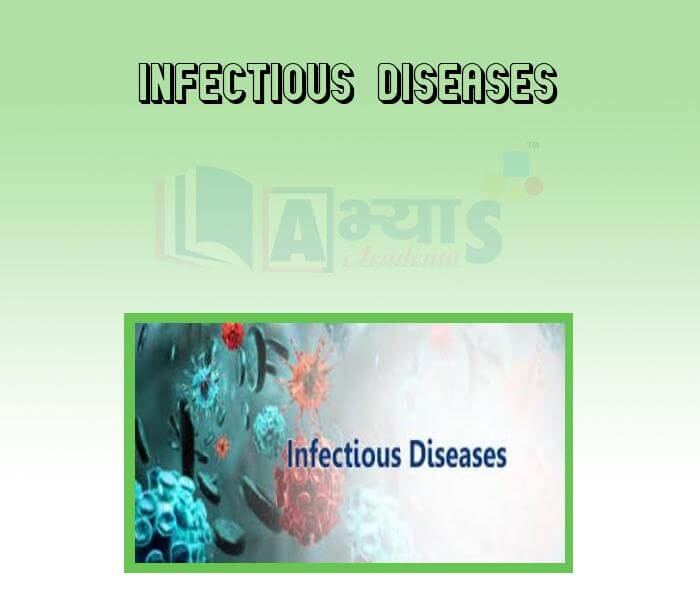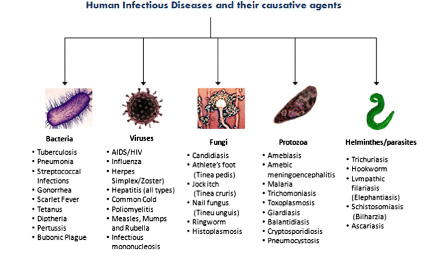Infectious Diseases











Infectious Diseases
Infectious diseases or communicable disease : An infectious disease that can be spread from one infected individual to another is called a communicable disease. An infectious disease can be spread from an infected person to a healthy person in many ways such as through food, water, air, direct contact, through a disease carrier like a mosquito, etc. Some infectious diseases are not communicable.
For example, tetanus is an infectious disease which affects the nerves and muscles of the patient. It is caused by a bacterium which enters the body when a wound comes in contact with contaminated soil or animal wastes. But tetanus cannot be spread from person to person. So, it is not a communicable disease.
Infectious diseases are caused by some biological agents (pathogens) such as viruses, bacteria, fungi and single- celled animal protozoans, etc. The presence of an infectious agent may affect the normal body function of the individual, leading to a disease. These can rapidly spread from one person to another by various means such as water, air, food, insects (vectors) or by physical contact. Some infectious diseases that develop and spread rapidly to many people are called epidemic diseases.
Infectious Agents: The unicellular or multicellular organisms that cause infection are called infectious agents. These disease causing organisms are also called pathogens and they are classified into a wide range of categories. Some of them are viruses, bacteria, fungi, protozoans, etc.
NOTE:
Corona disease 2019 (COVID-19) is also an infecticious disease. It is a contagious respiratory and vascular disease caused by SARS-CoV-2 virus.The first case was identified in Wuhan. Common symptoms of COVID-19 includes fever, cough, fatique,breathing difficulties,and loss of smell and taste.Symptoms begin in one to fourteen days after exposure to the virus.

Mumps is caused by which type of gland? | |||
| Right Option : C | |||
| View Explanation | |||
The primary host of plasmodium is _________________. | |||
| Right Option : D | |||
| View Explanation | |||
Which of the following diseases is a non infectious disease ? | |||
| Right Option : D | |||
| View Explanation | |||
Students / Parents Reviews [10]
Abhyas Methodology is very good. It is based on according to student and each child manages accordingly to its properly. Methodology has improved the abilities of students to shine them in future.

Manish Kumar
10thMy experience was very good with Abhyas academy. I am studying here from 6th class and I am satisfied by its results in my life. I improved a lot here ahead of school syllabus.

Ayan Ghosh
8thMy experience with Abhyas is very good. I have learnt many things here like vedic maths and reasoning also. Teachers here first take our doubts and then there are assignments to verify our weak points.

Shivam Rana
7thBeing a parent, I saw my daughter improvement in her studies by seeing a good result in all day to day compititive exam TMO, NSO, IEO etc and as well as studies. I have got a fruitful result from my daughter.

Prisha Gupta
8thI have spent a wonderful time in Abhyas academy. It has made my reasoning more apt, English more stronger and Maths an interesting subject for me. It has given me a habbit of self studying

Yatharthi Sharma
10thIt was good as the experience because as we had come here we had been improved in a such envirnment created here.Extra is taught which is beneficial for future.

Eshan Arora
8thAbout Abhyas metholodology the teachers are very nice and hardworking toward students.The Centre Head Mrs Anu Sethi is also a brilliant teacher.Abhyas has taught me how to overcome problems and has always taken my doubts and suppoeted me.

Shreya Shrivastava
8thAbhyas is a complete education Institute. Here extreme care is taken by teacher with the help of regular exam. Extra classes also conducted by the institute, if the student is weak.

Om Umang
10thOne of the best institutes to develope a child interest in studies.Provides SST and English knowledge also unlike other institutes. Teachers are co operative and friendly online tests andPPT develope practical knowledge also.

Aman Kumar Shrivastava
10thMy experience with Abhyas academy is very good. I did not think that my every subject coming here will be so strong. The main thing is that the online tests had made me learn here more things.
